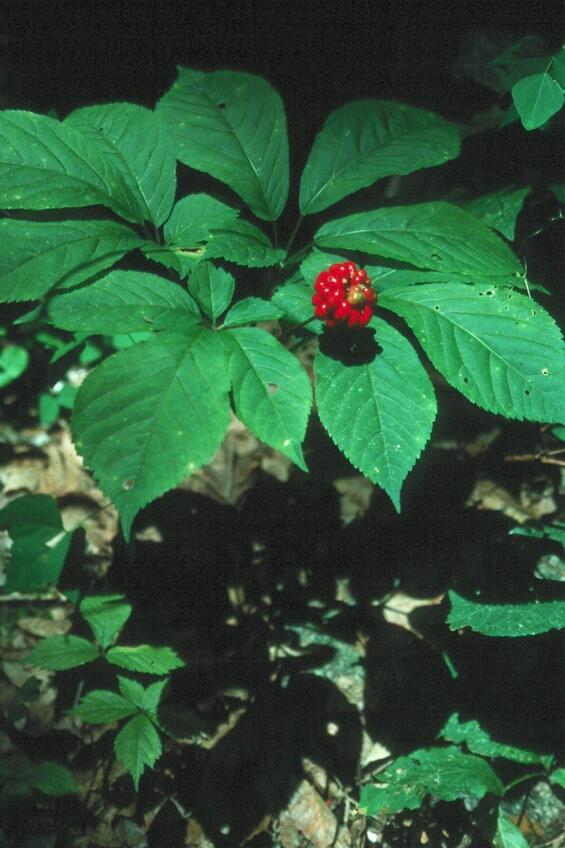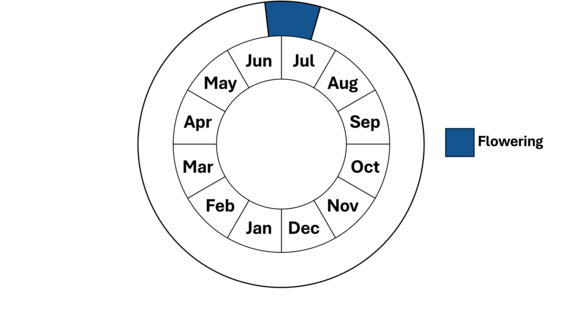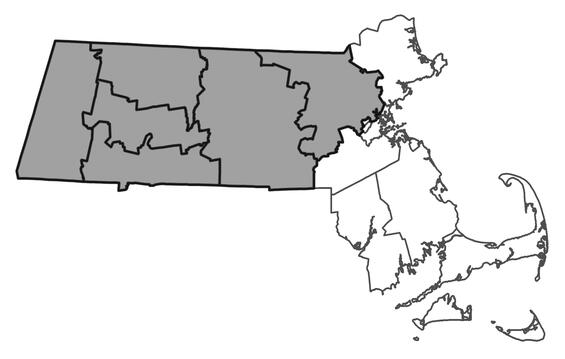- Scientific name: Panax quinquefolius
- Species of Greatest Conservation Need (MA State Wildlife Action Plan)
- Special Concern (MA Endangered Species Act)
Description

American ginseng (Panax quinquefolius)
American ginseng is a perennial herb long known for the reputed medicinal and aphrodisiac properties of its aromatic root. The genus name Panax reflects the reputed value of various species of ginseng as a cure-all or panacea. The unbranched stem is 20-40 cm (8-15 in) high and is topped by a single whorl of 1 to 5 palmately compound leaves. Usually, three compound leaves are produced, each with five serrate (pointed and toothed) leaflets. The tiny flowers are produced in a single, ball-like cluster in the fork where the leaf stalks meet the stem. The five-petalled flowers are white or greenish-yellow and are scented like lily-of-the-valley. They appear from late June to mid-July. The fruits, bright red drupes one cm (0.4 in) in diameter, are easily seen in the fall. American ginseng plants less than three years old usually bear no fruit, and it takes 18 to 22 months between the time when the ripe fruit drops to the ground and the time the seed will germinate.
Virginia creeper (Parthenocissus quinquefolia), like American ginseng, has five palmate leaflets, but it is usually a climbing or sprawling vine with tendrils. Also, the leaves of Virginia creeper are alternately arranged, unlike the whorled leaves of American ginseng. Wild arsaparilla (Aralia nudicaulis) is also similar in appearance to American ginseng. In contrast to American ginseng, its five leaflets are pinnately, not palmately, arranged and its flowers are borne on a stalk separate from the leafy stem. Dwarf ginseng (Panax trifolium) has three leaflets that are directly attached to the leaf stalk and are smaller than the leaflets of American ginseng.
Life cycle and behavior
This is a perennial species.

American ginseng (Panax quinquefolius)
Population status
American ginseng is currently listed as a species of special concern in Massachusetts. As with all species listed in Massachusetts, individuals of the species are protected from take (picking, collecting, killing) and sale under the Massachusetts Endangered Species Act. Species of special concern have been documented to have suffered a decline that could threaten the species if allowed to continue unchecked or have such a restricted distribution or specialized habitat requirement that they could easily become threatened within Massachusetts. There are 75 current stations (discovered or verified since 1984) and 18 historical stations (unverified since 1979) in the Commonwealth. Nationwide, American ginseng is considered to be a locally threatened species because of over-harvesting, primarily for export to China. States where the plant is considered to be rare include Maine, New Hampshire, Vermont, Connecticut, Rhode Island, New York, New Jersey, Delaware, Maryland, Virginia, West Virginia, Georgia, Illinois, Michigan, Minnesota, Kansas, Kentucky, Louisiana, Mississippi, Tennessee, Oklahoma, Iowa, Indiana, Nebraska, and South Dakota. In an effort to stabilize populations, the U.S. Fish and Wildlife Service has required permits for interstate commerce and overseas export. These permits are limited to states that demonstrate adequate monitoring programs. The extent of the harvest in Massachusetts is not known. American ginseng is listed under Appendix II of the Convention on International Trade in Endangered Species.
Distribution and abundance
American ginseng is distributed in mesic woodlands throughout eastern North America, from southern Ontario and Quebec to Manitoba and Minnesota, south to northern Florida, Louisiana, and Oklahoma. Colonies are usually small, but very rarely colonies may be as large as 200 individuals. In Massachusetts, they are generally between 5 and 20 individuals.

Distribution in Massachusetts. 2000-2025. Based on records in the Natural Heritage Database.
Habitat
American ginseng favors cool, well-drained soils of rich, moist deciduous woods. It may also be found on rocky talus slopes. Among the specific habitats in Massachusetts are a variety of rocky habitats, including the tops of ledges, rocky talus slopes and jumbles, and rocky rich mesic woods; along a creek at the base of a fern-covered slope; and various rich mesic forest habitats, including ones at the base of a dolomitic limestone ledge and one in a ravine. None of the current sites is in full sun. Associated species include American basswood (Tilia americana), sugar maple (Acer saccharum), white ash (Fraxinus americana), jack-in-the-pulpit (Arisaema triphyllum), large-flowered bellwort (Uvularia grandiflora), wild leek (Allium tricoccum), showy orchis (Orchis spectabilis), butternut (Juglans cinerea), shagbark hickory (Carya ovata), Dewey’s sedge (Carex deweyana), wake-robin (Trillium erectum), and a variety of ferns (including Dryopteris spinulosa, Dryopteris goldiana, Polystichum acrostichoides, and Adiantum pedatum). Several other rare plants share the same habitat in Massachusetts.
Healthy habitats are vital for supporting native wildlife and plants. Explore habitats and learn about conservation and restoration in Massachusetts.
Threats
In general, populations of American ginseng are threatened because of the harvesting of the root and habitat destruction. The rich woods habitat of American ginseng is not widespread in Massachusetts, so there are limited areas available for the species to thrive. The fragmented condition of the forest habitat may interfere with natural reestablishment in heavily harvested or disturbed areas. American ginseng can also be killed by inadvertent trampling, sometimes by hikers or admirers looking at the spring flora of the rich woods habitat. Since it often grows in areas of loose rock, such as on talus slopes, it can easily be dislodged.
Conservation
To protect plants from both trampling and collecting, access to the areas where it grows should be impeded by rerouting paths or, possibly, the use of fencing. Because it is a collected plant, the locations of sites should not be publicized. Heavy grazing by cattle has also resulted in the extirpation of local populations. American ginseng reproduces very rarely by fragmentation of the rhizome; therefore, plants should not be disturbed during flowering and fruit set, and the seeds left on the plant. One study found that a decimated population was able to recover after several years, apparently through the persistence of viable seeds in the soil. The surrounding forest community had not been disturbed, which is thought to have contributed to the recovery. Because American ginseng does not grow in open sun, forest canopies should be left undisturbed.
Contact
| Date published: | May 1, 2025 |
|---|